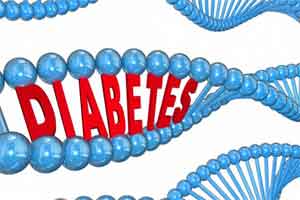- Home
- Editorial
- News
- Practice Guidelines
- Anesthesiology Guidelines
- Cancer Guidelines
- Cardiac Sciences Guidelines
- Critical Care Guidelines
- Dentistry Guidelines
- Dermatology Guidelines
- Diabetes and Endo Guidelines
- Diagnostics Guidelines
- ENT Guidelines
- Featured Practice Guidelines
- Gastroenterology Guidelines
- Geriatrics Guidelines
- Medicine Guidelines
- Nephrology Guidelines
- Neurosciences Guidelines
- Obs and Gynae Guidelines
- Ophthalmology Guidelines
- Orthopaedics Guidelines
- Paediatrics Guidelines
- Psychiatry Guidelines
- Pulmonology Guidelines
- Radiology Guidelines
- Surgery Guidelines
- Urology Guidelines
Indian Scientists Discover Link Between Obesity, Diabetes

Kolkata : In a major breakthrough, Indian scientists have zeroed in on key disease events triggering type 2 diabetes in obese people.
They say the novel findings open up avenues for drug development and therapy and could also help identify those susceptible to the disease affecting 64.5 million Indians.
With 9.8 million obese men and 20 million obese women (fifth and third rank respectively in the world in 2014), according to a study published in The Lancet journal, it is a double whammy for India.
Scientists at the CSIR-Indian Institute of Chemical Biology (CSIR-IICB), in collaboration with clinicians from ILS Hospitals, Kolkata, and Institute of Postgraduate Medical Education and Research (IPGMER), Kolkata, analysed fat tissues (visceral adipose tissue or VAT) of obese people undergoing bariatric surgery.
“A lot of obese people are getting diabetes type 2 (insulin resistance diabetes). Even in rural India, obesity is increasing. We have discovered a novel mechanism in the pathway that leads to type 2 diabetes in obese people. This is perhaps the root cause of the pathway and opens up possibilities for development of new drugs based on the finding,” immunologist Dipyaman Ganguly of CSIR-IICB told IANS.
Published in August in the journal Diabetes, the study builds upon existing data on the links between obesity and diabetes.
“When a person becomes obese, the fat cells in the adipose tissue accumulate fat. Previous research has established that immune cells called macrophages infiltrate fat tissue and produce chemical mediators called cytokines which leads to inflammation responsible for the eventual insulin resistance,” explained Ganguly.
But the question remained why the macrophages which usually respond to infections become activated in fat tissue.
“We found this link. When a person becomes obese, the fat cells get enlarged and they release a specific chemical called chemerin and this chemerin recruits specific immune cells called plasmacytoid dendritic cells (or pDCs) and these in turn drive macrophages to an activated stage and lead to inflammation,” said Ganguly.
Apart from a potential drug target, chemerin could also be used as a biomarker to pinpoint obese individuals who are more prone to diabetes, said Ganguly, clarifying not all obese individuals suffer from the non-communicable disease.
Although the study was performed on a specific Indian cohort, Ganguly believes researchers globally will take the findings forward and carry out analysis on different communities to gauge the link between obesity and insulin-resistance in those groups.
The key co-authors of the paper are Amrit Raj Ghosh, Om Tantia (who led the team of surgeons who recruited the patients and collected samples) and endocrinologist Satinath Mukhopadhyay from IPGMER.
According to the latest Lancet study, China, India and the US are among the top three countries with a high diabetic population.
“In about 70 per cent of cases in bariatric surgery, diabetes goes into remission. So with a biomarker, we can also check if there has been a drop in the levels of chemerin after surgery. Also, India has one of the highest rates of progression from metabolic syndrome to diabetes. We have to identify who are at risk, we can’t go on screening the entire population,” Mukhopadhyay said.

Disclaimer: This site is primarily intended for healthcare professionals. Any content/information on this website does not replace the advice of medical and/or health professionals and should not be construed as medical/diagnostic advice/endorsement or prescription. Use of this site is subject to our terms of use, privacy policy, advertisement policy. © 2020 Minerva Medical Treatment Pvt Ltd